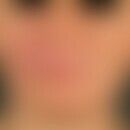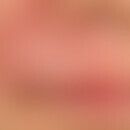Synonym(s)
HistoryThis section has been translated automatically.
Fuchs 1896; Laffer 1909; Ascher 1920;
A combination of blepharochalasis and double lip was first described by WB Laffer in 1909. In 1920, Ascher reported a "non-toxic enlargement" of the thyroid gland in combination with blepharochalasis and double lip.
DefinitionThis section has been translated automatically.
Ascher syndrome (also known as Laffer-Ascher syndrome) is a rare (about 100 case reports have been published worldwide), benign disorder characterized by a triad of blepharochalasis, double upper lip and non-toxic, euthyroid goiter. The clinical features are clear, making the diagnosis straightforward in most cases. Zhao ZL et al. (2019) described the association with Hashimoto's thyroiditis.
You might also be interested in
EtiopathogenesisThis section has been translated automatically.
Most cases of Ascher syndrome are sporadic, but familial cases have also been reported, suggesting autosomal dominant inheritance. Genes associated with blepharochalasis, such as the GSN gene, OSMR gene, ADAMTS2 gene, MMP3 gene and MMP9 gene, have already been reported (Motegi S et al. 2014).
Pathogenetically, recurrent edema is followed by sagging and atrophy of the upper eyelid skin, hyperplasia of the prolapsed orbital fat, double lip as a manifestation of post-edematous vascular and connective tissue proliferation. The etiopathogenetic connection with euthyroid goiter has not yet been clarified.
ManifestationThis section has been translated automatically.
The age of onset of the disease is generally in early childhood: no gender preference.
ClinicThis section has been translated automatically.
Repeated occurrence of painless swelling after the age of 5. The syndrome most commonly affects the eyelids first, later the lips are also affected. In about 1/3 of the case reports, the eyelid involvement preceded the lip involvement, in 1/3 of the cases the lip involvement, and in 20% of the cases the involvement occurred simultaneously. In affected patients, the swelling of the upper eyelids and upper lip is often initially misinterpreted as angioedema. Only blepharochalasis due to prolapsed orbital fat and lacrimal gland tissue confirms the diagnosis. The doubling of the lips (double lip) is also indicative; usually the upper lip is affected, rarely the lower lip (see Fig.).
After puberty, a euthyroid goiter may occur. In the full picture, there is a combination of blepharochalasis, double lip, goitre and endocrine disorders. Edematous lip swelling and blepharochalasis are initially reversible and eventually persistent due to fibrous transformation.
Differential diagnosisThis section has been translated automatically.
TherapyThis section has been translated automatically.
Symptomatic treatment of endocrine disorders by endocrinologists, surgical treatment of the goiter if necessary. Proven non-surgical treatment modalities include oral prednisolone, antihistamines and dapsone.
If necessary: surgical correction of the double lip and blepharochalasis.
Note(s)This section has been translated automatically.
During development, the upper lip mucosa has two transverse zones: the outer cutaneous zone (pars glabrosa) and the inner mucosal zone (paras villosa). In the double lip, there is a tissue duplication between the pars glabrosa and the pars villosa, which is particularly noticeable when patients smile. The term "double lip" therefore seems inappropriate, as the excess tissue is located in the pars villosa. In his original description, Laffer also mentioned the upper lip as being swollen, especially on its buccal side. In most cases the upper lip is affected, but in rare cases the lower lip or both lips are affected.
Thyroid gland and Ascher's syndrome: Ascher described an enlargement of the thyroid gland in several cases. However, non-toxic thyroid involvement has only been observed in about 15% of cases in the literature. It is not clear whether the presence of thyroid enlargement is a constant or a necessary feature for the diagnosis. Thyroid antibodies may occur. Thyroid involvement may also occur years after the onset of blepharochalasis and double lip
Case report(s)This section has been translated automatically.
Increasing blepharochalasis was noticed in a 46-year-old woman. The initial examination revealed bilateral blepharochalasis, which was more pronounced on the right side. Both the upper and lower lip were thickened and protruding. The patient stated that the thickening of the lips started almost 20 years ago and progressed gradually. Blepharochalasis appeared much later, almost 14 years after the lip thickening, and initially it was episodic and disappeared spontaneously, only to reappear.
There was no history of familiality, use of medications known to cause eyelid swelling or urticaria. The patient denied the use of mascara or eye shadow.
Opthalmologic examination, including visual acuity, eye movements, pupillary response, and systemic examination, was normal.
Sonographic and serologic thyroid findings were normal. The patient was informed about the surgical reduction of the thickened lip tissue and correction of the eyelid skin and was examined by a team consisting of an ophthalmologist and a plastic surgeon. Under general anesthesia, a single seated blepharoplasty and lip correction through a double elliptical excision were performed, and the tissue was sent for histopathologic examination.
Histopathologic examination revealed normal epidermis with loose dermis and dilated vessels along with perifollicular inflammatory infiltrates. The postoperative period was uneventful with a marked cosmetic improvement of the blepharochalasis and double lip after 2 months
LiteratureThis section has been translated automatically.
- Al-Hassani M et al. (2020) Ascher's syndrome: a rare cause of lip swelling. Ann R Coll Surg Engl 102:e216-e218. Fig
- Ascher KW (1920) Blepharochalasis with goiter and double lip. Klin Monatsbl Augenheilk (Stuttgart) 65: 86-97
- Donato CMG et al (2017) Do you know this syndrome? Ascher's syndrome: clinical findings of little known triad. An Bras Dermatol 92:729-730. ascher 6
- Fuchs E (1896) On blepharochalasis (sagging of the eyelid skin). Wiener klin Wochenschr 9: 109
- Gomez-Duaso AJ et al. (1997) Ascher syndrome: report of two cases. J Oral Maxillofac Surg 55: 88-90
- Hausamen JE, Solbach HG, Pape HD (1969) Clinical contribution to Ascher syndrome. Dtsch zahnärztl Z 24: 983-987
- Kara IG et al (2001) Ascher syndrome. Otolaryngol Head Neck Surg 124: 236-237
- Laffer WB (1909) Blepharochalasis. Report of a case of this trophoneurosis, involving also the upper lip. Cleveland Med J 8: 131-135
- Letra A et al. (2007) MMP gene polymorphisms as contributors for cleft lip/palate: association with MMP3 but not MMP1. Arch Oral Biol 52:954-960.
- Motegi S et al. (2014) Blepharochalasis: possibly associated with matrix metalloproteinases. J Dermatol 41:536-538
- Parmar RC et al. (2004) A newly recognized syndrome with double upper and lower lip, hypertelorism, eyelid ptosis, blepharophimosis, and third finger clinodactyly. Am J Med Genet 124A: 200-201
- Rewri P et al (2023) A Century of Laffer-Ascher Syndrome. Indian J Plast Surg 56:540-543.
- Zhao ZL et al. (2019) Ascher syndrome: a rare case of blepharochalasis combined with double lip and Hashimoto's thyroiditis. Int J Ophthalmol 12:1044-1046.
Incoming links (4)
Blepharochalasis; Double lip; Facial swelling, differential diagnosis; Macrochilelia;Outgoing links (10)
Adamts2; Blepharochalasis; Cheilitis granulomatosa; Double lip; GSN gene; Melkersson-rosenthal syndrome; MMP3 gene; Morbus Morbihan ; OSMR gene; Thyroiditis hashimoto;Disclaimer
Please ask your physician for a reliable diagnosis. This website is only meant as a reference.









